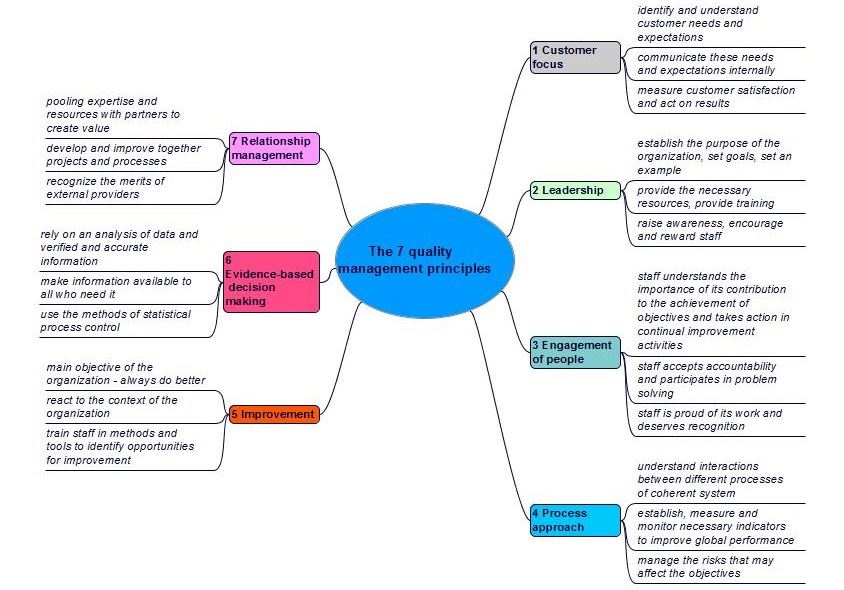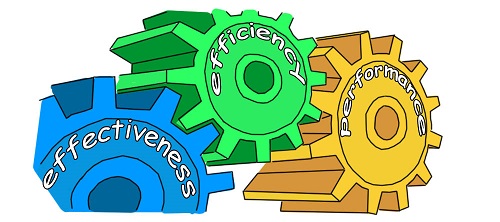4 Principles T 42
4.1 Management principles
Quality management principles
.jpg)
The seven quality managementactivities allowing the control of an organization with regard to quality (see also ISO 9000, 3.3.4) principles (cf. figure 4-1) will help us achieve sustained success (ISO 9001, sub clause 0.2).

Figure 4-1. The 7 quality management principles
4.2 Audit principles
Audit principles for the auditor, the audit and the auditee

Certain principles must be followed for an auditsystematic and independent survey to determine whether activities and results comply with pre-established measures and are capable of achieving the objectives (see also ISO 19011, 3.1) to be a value added tool.
For the auditoreveryone who is trained to carry out audits (see also ISO 19011, 3.8) :
- professional ethics, to guarantee:
- mutual trust
- compliance with legal requirements
- impartial presentation, to ensure:
- honest and precise audit conclusions
- detailed findings and audit reports
- professional integrity to guarantee:
- the importance of the task
- the trust given
- confidentiality, to treat with care information which is:
- sensitive
- confidential
- independence, to:
- conduct an impartial audit
- write objective conclusions
- the evidence-based approach, to reach conclusions that are:
- reliable, verifiable and
- reproducible
- risk-based thinking, to achieve the objectives of the audit by:
- identifying and decreasing threats
- seizing opportunities
But also:
- common sense - always the best tool
- curiosity, to learn and succeed
- goodwill to help the auditee identify improvement opportunities
- understandable language
- positive attitude is gratifying for the auditee
- independence (the auditor and audited activity do not have conflicts of interest), to guarantee:
- objective conclusions
- findings based on objective evidence
- a factual approach, to ensure:
- the audit evidence is verifiable
- the audit conclusions are repeatable
For the auditeeeveryone who is audited (see also ISO 19 011, 3.7):
- remain available
- do not try to hide the truth
- do not be afraid of the answers
- objectively accept the nonconformities found
- be aware of participating in the improvement of the QMS by being:
- benevolent and
- cooperative
An auditoreveryone who is trained to carry out audits (see also ISO 19011, 3.8) cannot audit their own department as
No-one should be a judge in his own case. Latin proverb
 Minute of relaxation. Cf. joke "The engineer and the shepherd"
Minute of relaxation. Cf. joke "The engineer and the shepherd"
4.3 Performance of the QMS
Performance, effectiveness, efficiency

For a quality management systemset of processes allowing the achievement of the quality objectives (see also ISO 9000, 3.5.4) what is of interest is the degree of achievement of objectives or, in other words, performance. The performance of a QMSQuality Management System is measured by its effectivenesscapacity to perform planned activities with minimum effort (see also ISO 9000, 3.7.11) and, above all, by its efficiencyfinancial relationship between achieved results and resources used (see also ISO 9000, 3.7.10) (see figure 4-2).
.gif)
Figure 4-2. Performance of a QMS
Effectiveness: capacity to perform planned activities with minimum effort
Efficiency: financial relationship between achieved results and resources used
.jpeg) |
N.B. We can be effective because we achieved our objective, but are not efficient if we used too many resources or tolerated and produced too much waste! |
.jpg) Minute of relaxation. Game: Audit principles
Minute of relaxation. Game: Audit principles
The rest of the T 42v16 ISO 13485 internal audit version 2016 training is accessible on this page.
See also the training T 22v16 ISO 13485 readiness version 2016 and the training package ISO 13485 version 2016.
